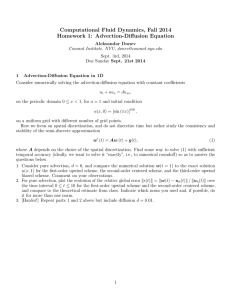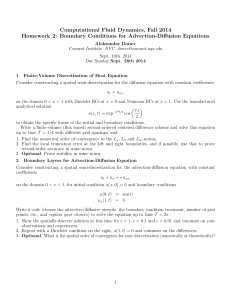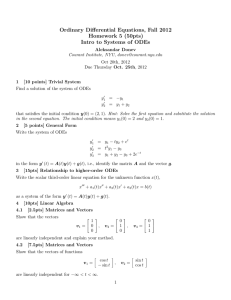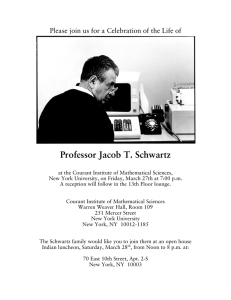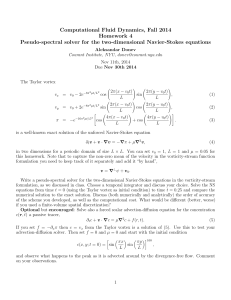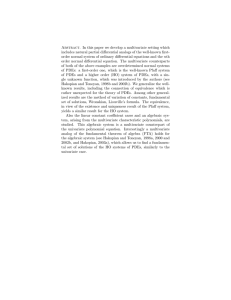Scientific Computing: Partial Differential Equations Aleksandar Donev Courant Institute, NYU
advertisement
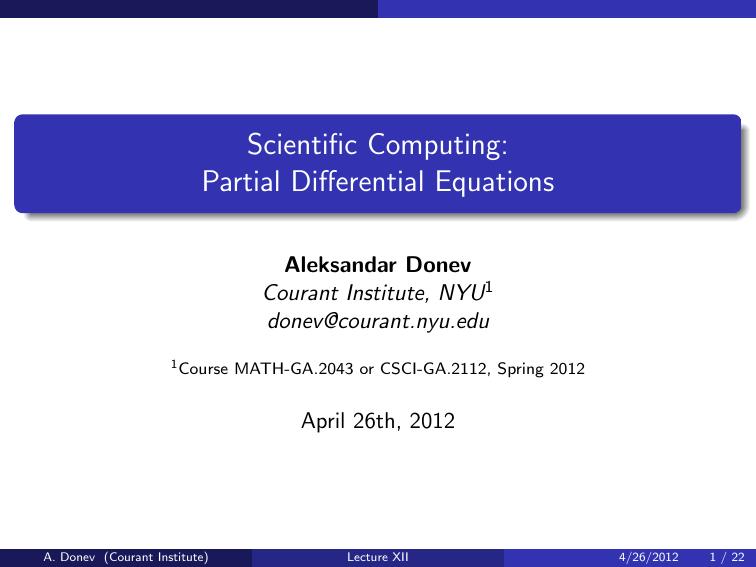
Scientific Computing: Partial Differential Equations Aleksandar Donev Courant Institute, NYU1 donev@courant.nyu.edu 1 Course MATH-GA.2043 or CSCI-GA.2112, Spring 2012 April 26th, 2012 A. Donev (Courant Institute) Lecture XII 4/26/2012 1 / 22 Outline 1 Classification of PDEs 2 Numerical Methods for PDEs 3 Conclusions A. Donev (Courant Institute) Lecture XII 4/26/2012 2 / 22 Classification of PDEs Partial Differential Equations Partial differential equations (PDEs) are differential equations that involve more then one independent variables. PDEs appear prominently in the modeling of physical systems, and so we will assume the independent variables are time t and spatial coordinate x in one dimension, or in higher dimensions r, so our unknown is u(x, t) or more generally u(r, t) For time-independent problems, we will focus on two-dimensional problems, u(r) ≡ u(x, y ). Common short-hand notation for derivatives in PDE circles: ∂u ∂2u = ∂t u = ut , and = ∂xy u = uxy ∂t ∂x∂y The order of the PDE is determined by the highest-order partial derivative appearing in the PDE. A. Donev (Courant Institute) Lecture XII 4/26/2012 4 / 22 Classification of PDEs First Order Linear PDEs The simplest first-order linear PDE is the advection equation ut = −cux , where c is a constant speed of propagation. If the domain of x-dependence is the whole real line, one needs an initial condition at time t0 = 0, u(0, x) = u0 (x) for x ∈ R. The solution of the equation can be constructed analytically for any initial condition: u(x, t) = u0 (x − ct), which means at time t the solution is the same as at time t0 but shifted by a distance c(t − t0 ). If c > 0 information propagates upward, and if c < 0 information propagates downward. A. Donev (Courant Institute) Lecture XII 4/26/2012 5 / 22 Classification of PDEs Advection Equation Now consider the case when the domain of the PDE is a finite interval, 0 ≤ x ≤ 1, with initial condition u(0, x) = u0 (x) for 0 ≤ x ≤ 1. If c > 0, then at a later time t the solution would shift upward and we would not know what it is for x < ct. To specify the problem we thus also need boundary conditions, if c > 0 then u(0, t) = uL (t), where uL (t = 0) = u0 (x = 0), or if c < 0 then u(1, t) = uR (t), where uR (t = 0) = u0 (x = 1). A. Donev (Courant Institute) Lecture XII 4/26/2012 6 / 22 Classification of PDEs Second-Order PDEs Consider a second-order linear equation with constant coefficients: auxx + buxy + cuyy + dux + euy + fu + g = 0. Depending on the values of the coefficients, this equation is classified as: b2 > 4ac: hyperbolic b2 = 4ac: parabolic b2 < 4ac: elliptic The type of the equation makes a profound effect on how it is solved numerically. In real life, the coefficients depend on time or the spatial position instead of being constants, and one usually considers systems of SPDEs which may be of mixed type. A. Donev (Courant Institute) Lecture XII 4/26/2012 7 / 22 Classification of PDEs PDE Classification However, based on the most prominent character in the PDE, one still uses the classification loosely: Hyperbolic problems are time-dependent problems where there is no steady-state and no dissipation (diffusion), such as the advection equation or the wave equation: utt = uxx . Parabolic problems are time-dependent problems evolving toward a steady-state because of dissipation (diffusion), such as the heat equation: ut = µuxx , where µ > 0 is heat conductivity. Elliptic problems are time-independent problems that describe the steady-state reached by parabolic PDEs, such as the Laplace equation: ut = uxx + uyy = 0. A. Donev (Courant Institute) Lecture XII 4/26/2012 8 / 22 Classification of PDEs Heat Equation In one spatial dimension, ut = µuxx , for 0 ≤ x ≤ 1, with initial conditions u(0, x) = f (x) for 0 ≤ x ≤ 1 We also need one boundary condition for each of the end-points of the interval (in higher dimensions for each point along the boundary), e.g., Dirichlet boundary conditions u(t, 0) = uL (t), and u(t, 1) = uR (t) or Neumann boundary conditions ∂u ∂u (t, 0) = 0, and (t, 1) = 0. ∂x ∂x The heat equation describes, for example, the temperature along the length of a rod where the ends are being held at specified temperatures (Dirichlet) or are insulated (Neumann). A. Donev (Courant Institute) Lecture XII 4/26/2012 9 / 22 Numerical Methods for PDEs Spatio-Temporal Discretization The first step in solving a PDE is spatio-temporal discretization of the solution, that is, representing the infinite-dimensional object u(x, t) as a discrete collection U of values (a vector, matrix, or array) representing the solution over the spatial domain over some period of time 0 ≤ t ≤ T . From the discrete solution U, one should be able to obtain an approximation of u(x, t) at any desired point in space and time inside the proper domain, for example, using interpolation. As a simple example, one could represent the solution on a discrete spatio-temporal grid, (k) Ui ≈ u(i∆x, k∆t), for i = 0, 1, . . . , N, and k = 0, 1, . . . The same concepts of and relations between consistency, stability and convergence as for ODEs apply for (linear) PDEs. A. Donev (Courant Institute) Lecture XII 4/26/2012 11 / 22 Numerical Methods for PDEs Spatial Discretization ut = f (u, ux , uxx ) Often, we construct the spatial discretization separately from the temporal one. This semidiscrete method converts a PDE into system of N ODEs ∂t U(t) = F [U (t) , t] , where U(t) ∈ RN is a discrete approximation to u(x, t). F [U (t) , t] is a consistent discretization of f (u, ux , uxx ), with error O(h2 ) = O(N −2 ) measured in an appropriate norm, where the grid spacing h = ∆x is a measure of the granularity of the spatial discretization. Then time is discretized, as for ODEs, with either a fixed or a variable time step ∆t. A. Donev (Courant Institute) Lecture XII 4/26/2012 12 / 22 Numerical Methods for PDEs Finite-Something Method Depending on how space is discretized, we distinguish the following classes of methods: Finite-difference methods, where the solution is represented pointwise on a discrete set of nodes, e.g., a regular grid: Ui (t) ≈ u(i∆x, t), for i = 0, 1, . . . , N Finite-element methods, where the solution is directly represented through the interpolant, that is, U(t) actually stores the coefficients of the interpolating function ũ(x; t), or more specifically, the coefficients of a discrete set of N basis functions. Equations for the coefficients are obtained by integration of the PDE over the domain (weak formulation). Finite-volume methods, where the solution is represented by the average values over a set of cells (integral over the cell). If the solution is time-independent (steady-state, ut = 0), then the problem simply becomes that of solving the system of N equations, F (U) = 0. A. Donev (Courant Institute) Lecture XII 4/26/2012 13 / 22 Numerical Methods for PDEs Finite-Difference Method The idea behind finite-difference methods is simple: Use finite-difference formulae to approximate derivatives. For example, one can use the second-order centered difference (see Lectures 2 and 3 and Homework 1): Ui+1 − Ui−1 ux (i∆x) ≈ 2∆x Ui+1 − 2Ui + Ui−1 . ∆x 2 For example, for the heat equation ut = µuxx we get the system of ODEs: Ui+1 (t) − 2Ui (t) + Ui−1 (t) ∂t Ui (t) = Fi (U) = µ , ∆x 2 where at the boundary points we use the boundary conditions, for example, for Dirichlet BCs we fix uxx (i∆x) ≈ U0 (t) = uL (t), A. Donev (Courant Institute) UN+1 (t) = uR (t). Lecture XII 4/26/2012 14 / 22 Numerical Methods for PDEs Temporal Integrators ∂t Ui (t) = µ Ui+1 (t) − 2Ui (t) + Ui−1 (t) ∆x 2 ⇒ ∂t U = µ AU ∆x 2 Recall that the stiffness of this system of ODEs is measured by the eigenvalues of µA/∆x 2 . Here A is a tri-diagonal matrix with −2 on the diagonal, and 1 on the off-diagonal. In one spatial dimension, the non-zero eigenvalues are in the interval λi ∈ [− 4µ π2µ , − ], ∆x 2 (N∆x)2 which means that the ratio of the largest to the smallest eigenvalue (in magnitude) is r ∼ N 2 . The system of ODEs becomes very stiff as the spatial discretization is refined (not good!). A. Donev (Courant Institute) Lecture XII 4/26/2012 15 / 22 Numerical Methods for PDEs Explicit Scheme Consider using forward Euler method with a fixed time step ∆t, and (k) denote Ui ≈ Ui (k∆t): (k+1) Ui (t + ∆t) = Ui (k) = Ui + µ∆t (k) (k) (k) U − 2U + U i+1 i i−1 . ∆x 2 Euler’s method will be stable if ∆t < 2 ∆x 2 = , maxi |Re(λi )| 2µ which is a manifestation of the so-called Courant-Friedrichs-Lewy (CFL) stability condition µ∆t 1 < . 2 ∆x 2 A. Donev (Courant Institute) Lecture XII 4/26/2012 16 / 22 Numerical Methods for PDEs Implicit Schemes ∂t U = µ AU ∆x 2 If one uses an implicit method such as Crank-Nicolson the time step can be increased, but a linear system must be solved at each time step: " # U(k+1) − U(k) µ U(k+1) + U(k) = A . ∆t ∆x 2 2 For time-independent problems, e.g., elliptic PDEs, one may need to solve a non-linear system of equations but Newton’s method will ultimately require solving a similar linear system! The linear systems that appear when solving PDEs have large but sparse and structured matrices. Often preconditioned iterative methods are used. A. Donev (Courant Institute) Lecture XII 4/26/2012 17 / 22 Numerical Methods for PDEs Advection Equation ut = −cux Consider first a finite-difference explicit method that uses a centered difference approximation to ux : (k+1) Ui (k) (k) − Ui ∆t = −c (k) Ui+1 − Ui−1 2∆x While this seems reasonable, this scheme is unconditionally unstable for any time step ∆t. If one uses at least a third-order Runge-Kutta scheme one can get a conditionally stable scheme. A. Donev (Courant Institute) Lecture XII 4/26/2012 18 / 22 Numerical Methods for PDEs Upwinding Instead, we need to use the physics of the equation (direction of information propagation), to come up with a upwind discretization that uses one-sided derivatives: (k) (k) (k+1) (k) −c Ui −Ui−1 if c > 0 Ui − Ui ∆x = (k) (k) −U Ui+1 ∆t if c ≤ 0 −c ∆x i The upwind method is stable if the CFL stability condition is satisfied: ∆x ∆t < |c| Constructing schemes that are stable and have good order of accuracy and are also efficient is often an art form and relies heavily on past experience and lessons learned over the years. There is little systematic guidance... A. Donev (Courant Institute) Lecture XII 4/26/2012 19 / 22 Conclusions Example: Pricing European Options The Black-Scholes equation for the price of a European option V (S, t) given the price of an underlying asset S(t): ∂V σ2 ∂ 2V ∂V = − S 2 2 − rS + rV , ∂t 2 ∂S ∂S with certain boundary conditions. This combines advection (the term VS ) with something like diffusion (the term VSS , but it has the wrong sign in this choice of time direction). For this particular equation a (complicated but famous) transformation of variables shows that this is just a heat equation in disguise, σ2 ut = uxx , 2 with appropriate initial conditions (depends on type of option). A. Donev (Courant Institute) Lecture XII 4/26/2012 21 / 22 Conclusions Conclusions/Summary The appropriate numerical method for solving a PDE depends heavily on its type: hyperbolic (advection, wave), parabolic (heat) or elliptic (Poisson or Laplace), or mixed, e.g., advection/convection-diffusion equation. The first step in solving a PDE is the construction of a spatial discretization of the solution: finite-difference, finite-element or finite-volume. This leads to a large system of ODEs that can in principle be solved with any of the methods we already discussed. Using an explicit method leads to a severe CFL time-step restriction due to increasing stiffness as the discretization is refined. One can use implicit methods but this requires solving a large sparse linear system at every time step. A. Donev (Courant Institute) Lecture XII 4/26/2012 22 / 22
